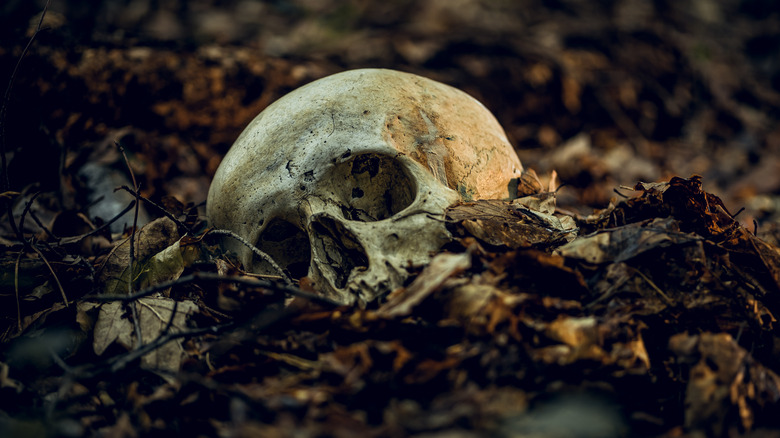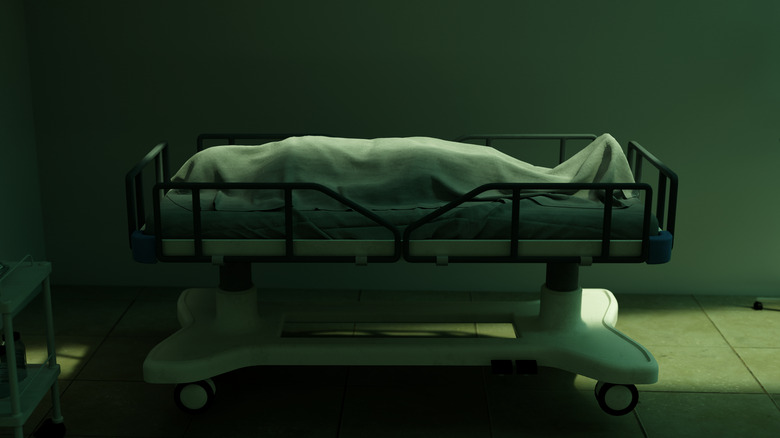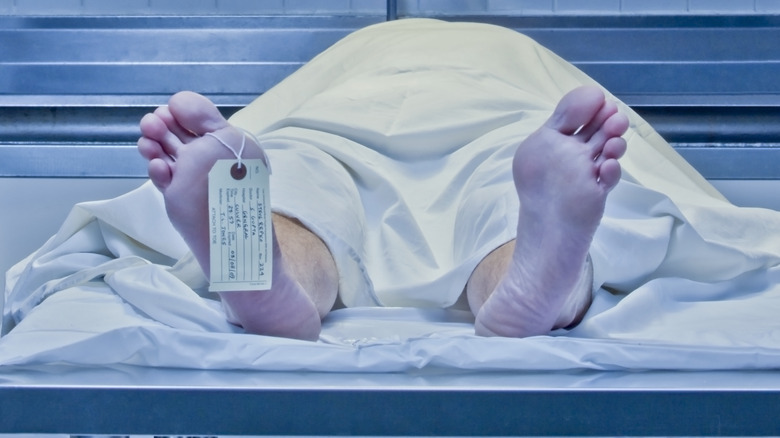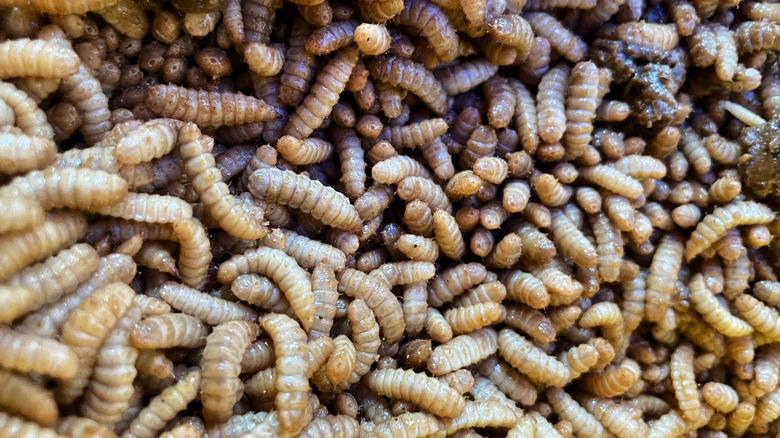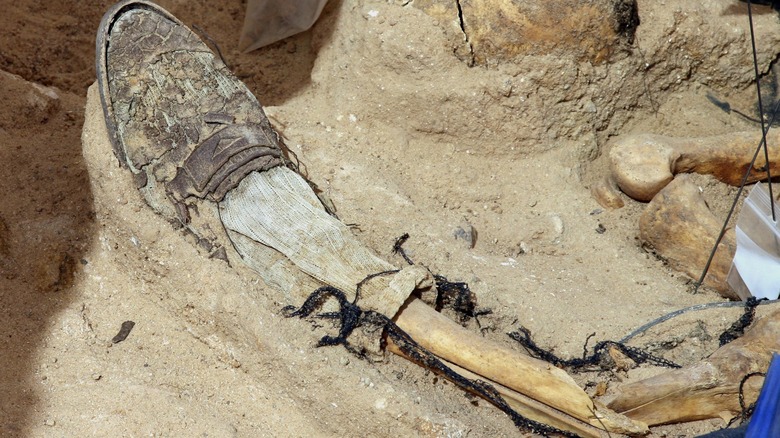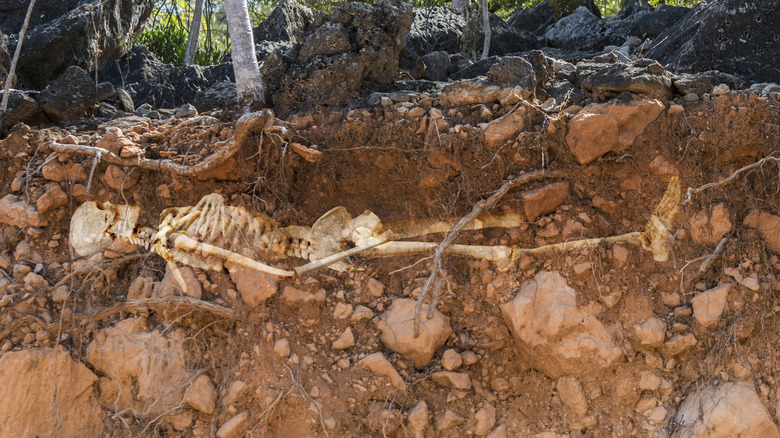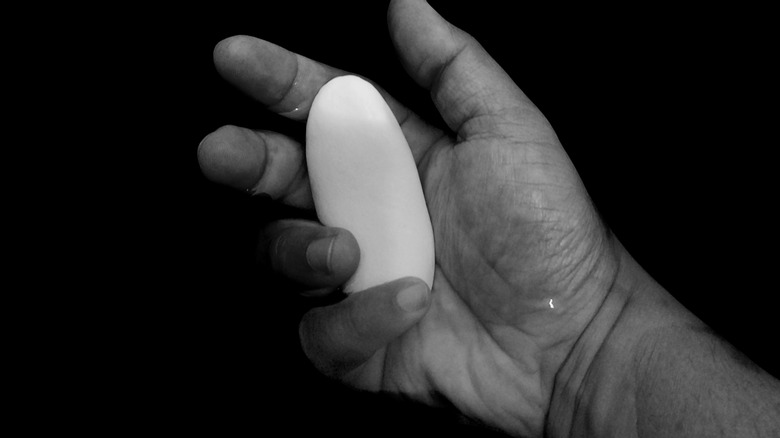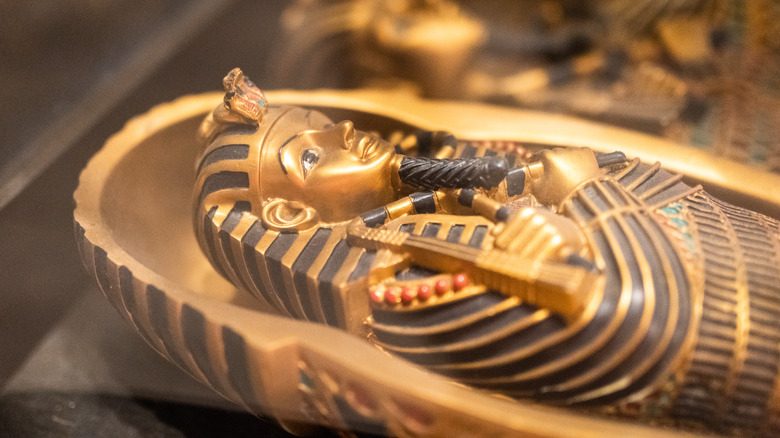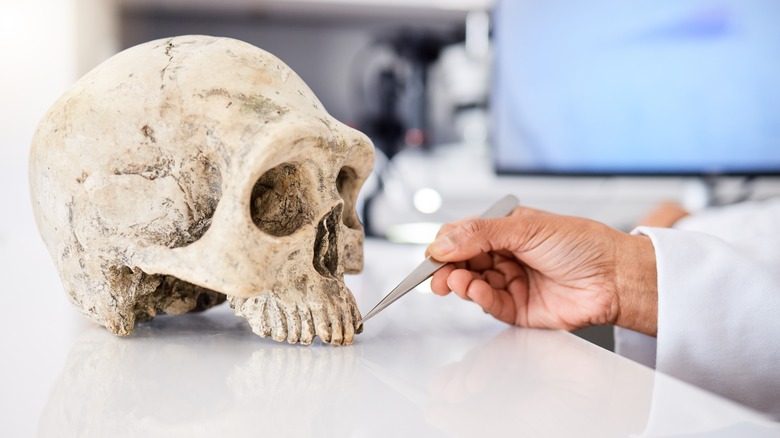How Long Does It Take For A Body To Decompose And What Are The Stages?
Death might be the great equalizer, but what happens to the body afterward is far from the same for everyone. While all bodies that aren't, say, cremated will eventually decompose, the road from our last breath to the total decomposition of our bodies can potentially take many forms.
Yes, there are certain basic stages of decomposition things that we all can expect to happen to our mortal remains after death. What's more, science even has a fairly good idea about the time frame of said stages. However, the decomposition processes of different bodies can be greatly impacted by various outside factors. Because of this, the decomposition highway has surprisingly many lanes and they don't all lead to the same destination.
So how long does it take for the human body to decompose, and what usually happens during this process? Let's find out, and also take a look at some peculiar exceptions that might disrupt the process, speed it up, or even cancel it altogether.
How long does it take for the human body to decompose?
Let's start with the big question: Once a person dies, how long will it take for their body to decompose? The answer is simultaneously very simple and extremely complicated. All things considered, decomposing can take anything from two weeks to over two years. There are many stages in the process, and as this article will reveal, various environmental and other factors can impact this time quite significantly — in both directions, no less.
Two of the main things that affect decomposing are basically the same ones you pay attention to when you check the weather report — temperature and humidity. The hotter it gets, the quicker the decomposing processes become. Meanwhile, water and cold can slow them down. Oxygen is also a factor, and the less the body is exposed to it, the slower it takes to decompose. Finally, the pH value of the environment matters. The more extreme it is in either direction, the quicker our remains tend to decompose.
That's a whole lot of variables, which means it's very hard to give an all-encompassing, reliable answer to the timeline of a body's decomposing process. However, it's entirely possible to give ballpark figures to its various stages, as long as we know the specific circumstances of the body in question. As such, the following slides explore the decomposition stages of an unburied body that's fully affected by the elements.
What constitutes the death of a human body?
There are many ways to define death, from assorted cultural and religious definitions to the sheer difficulty of pointing out the exact moment "alive" stops and "dead" begins. Scientifically speaking, death has been described as a process that shuts down a person's bodily functions until the brain and the rest of your body are fully dead. Heart and lungs are the key, here — at a point where the blood gets no oxygen from breathing or the heart pumps no more blood to the body, the cells start dying.
Brain cells are the first to go, which happens after roughly 3 minutes without oxygen. The dying process then moves to other parts of the body, with skin cells the last to go. The entire process can last surprisingly long — skin and bone cells can potentially stay alive for several days. However, decomposition of brain and liver can happen mere minutes after their cellular death. This means that different parts of the body can simultaneously be alive and rot — a chilling thought that's nevertheless a natural part of the process.
The first stage of decomposition: Fresh phase
The first stage of decomposition constitutes the early, comparatively presentable phases of a dead person's remains. These can take up to six days in an exposed body. A lack of blood circulation causes the body to start to pale in an effect known as pallor mortis. Carbon dioxide begins breaking down cell membranes, which releases enzymes that start breaking tissues down from the inside.
The most famous stage of this early part of decomposition processes is arguably rigor mortis. Three to four hours after death, the body's smaller muscles start stiffening, and a few hours later larger muscles follow. Rigor mortis gets worse and subsides in stages over the course of some 36 hours, and it can be quite disconcerting thanks to the potentially unnerving expressions the stiffened facial muscles can force on the body's face.
As rigor mortis takes its course, the body cools in the algor mortis phenomenon, and the beginnings of the internal turmoil of decomposition become visible. Blood starts concentrating in pools inside the body in a process called livor mortis, staining said areas purple. Forensic pathology considers rigor mortis, livor mortis and algor mortis a classic trifecta of early changes to the body, and they all play a part in determining the time of death.
The bloated stage swells the body up
According to forensic pathology, the second stage of decomposition is known as early decomposition phase. In a nutshell, this involves severe bloating and liquefication of soft tissues.
An exposed body's bloated stage might be in full swing around day 7 and may spend a little over two weeks in that state. At this point, the body's internal putrefaction processes and the ensuing gases start steadily swelling up the body. It's worth noting that since the processes related to it happen in stages, certain parts of early decomposition can actually kick off as early as 24 hours after death.
A dead body is a full-on ecosystem, and at this point, both the microbes it already contained and the ones that have found their way to it are having a feast. As a result of their activity, the body's soft parts are increasingly turning into liquids and gases. The latter, in particular, contribute to the body's increasing bloat, which will eventually either release through the same channel a living body tends to release gas from, or possibly tear a hole in the body in its search for release. The bloat tends to be most prominent in the abdomen, but also affects other parts of the body. Understandably, this stage puts the body through a lot, which results in considerable color changes in the skin, leaking fluids, pungent odors — and a phenomenon called degloving, where the skin detaches from the body like a glove.
The advanced decay stage unleashes what lies within
An exposed body's full decay might start somewhere around day 24, and forensic pathology calls it the advanced decomposition phase. This is where the body is mushy enough for maggots and worms to join the party, and the remaining soft tissues are essentially liquid and rapidly lost. The skin is hard and dry, and parts of the skeleton start to show.
This is a stage where the outside elements can really take their toll on the body — or help preserve it. Temperature, moisture, the environment's acidity or alkalinity, and the level of oxygen exposure to the body all play a role in how the advanced decay phase treats the desiccating remains. Certain combinations of these environmental conditions may yield some strange and surprising results that we'll look into in a minute.
Essentially, the advanced decay stage is the endgame of the body's putrefaction process. After it's done, the body's liquids are by and large gone, and the "dry" stage of decomposition can begin.
The dry stage slows things down
The dry stage, which is known as the skeletonization phase in forensic pathology's handbook, starts at around day 54 in our fully exposed example body. As usual, of course, reaching this stage could take much more or less time, depending on the particular conditions of the body.
Along with the fresh phase — during which rigor mortis takes place and the body isn't too far into the decomposition process — the dry stage of decomposition sees the body in the kind of condition you may see in movies and TV shows. At this point, the bloating and oozing is over. This is a body that has already been through a lot. A significant portion of skeleton is likely already exposed, with dry remains of skin and other sturdier soft elements still present.
It's anyone's guess how rapidly things will proceed from here. The body will ultimately be stripped down to nothing but bones. However, this can easily take years, depending on the body's situation and exposure ... and somehow, it still isn't the final stage of decomposition.
Given enough time, even bones can decompose
A look at famous ossuary structures like the bone-filled Paris Catacombs or the Sedlec Ossuary in the Czech Republic may be enough to convince a person that bones can last forever — or at least long enough to be used as architectural elements. However, as forensic pathology's fifth stage of decomposition proves, even the sturdiest bones can eventually fall apart.
The extreme decomposition phase is a lengthy stage where the skeleton itself breaks down. Sufficiently exposed bones will start bleaching and weakening over the months or years. Their collagen proteins will eventually break down, which leaves the remaining mineral structure brittle enough to slowly erode away. At this point, we're talking about years or decades, unless external elements radically influence the process. Still, while it might take a long time, even the skeleton will be gone one day.
There is one possibility to avoid this total loss, though. If the mineral content and dryness of the soil happens to be just right, the bones' minerals will bond with the soil minerals and the skeleton becomes a fossil.
Grave wax is a grim side product of decomposition
Now that we've gone through the process of a body dying and decomposing into nothing (or becoming a neat skeleton fossil), it's time to look at some of the strange things that affect decomposition ... or, as the case may be, are created as its byproducts, such as grave wax.
Decomposition can actually turn part of the body into adipocere, colloquially known as grave wax. Adipocere forms in sufficiently moist conditions from large fat deposits in the body. They start turning into a greasy substance, and as decomposition progresses, this dries up into wax. This happens courtesy of a chemical process called saponification, which is also how soap is made from animal fat.
In some cases, the body may form quite a lot of grave wax — so much, in fact, that it develops around the entire body and effectively seals it in a protective shell. This stops decomposition and turns the body into a "soap mummy." This isn't quite as rare as you'd expect, and sufficiently wet cemeteries have been known to discover that many of the bodies buried there have become soap mummies over time.
Are there ways to prevent or delay decomposition?
The environment can affect the decomposition process greatly. A body buried in a casket can take a lot longer to decompose than a more exposed one, but there are several other, stranger factors that can preserve the body to various degrees.
Cold temperatures can slow down the decomposing process, as anyone who's seen a morgue locker scene in a police procedural no doubt knows. The field of cryonics has taken this idea further by devising methods to replace a recently dead person's blood with a protective chemical cocktail and freeze it in liquid nitrogen for potential revival at some point in the future. Less hopeful but also effective ways to preserve a dead body — or at least parts thereof — are embalming and mummification, both of which have been used to treat the body in various physical and chemical ways to preserve it as long as possible. Mummification of the body can also happen naturally in certain dry and warm conditions.
One exotic way to preserve a dead body is tanning. This has been known to happen when the body is buried in a highly acidic, low-oxygen environment such as a peat bog, and the phenomenon is responsible for well-preserved but leathery bog bodies like the 2,300-year-old Tollund Man. On the other end of the spectrum, there's the distinctly man-made process of plastination, where body parts are preserved with polymer plastic that isolates them from the environment entirely.
What's the fastest way for a body to decompose?
A natural decomposition can take weeks, months, or even years. However, in one very particular situation, it can happen much, much faster.
Any exposed, decomposing body is a biosystem that's breaking down and scavenged by bacteria, fungi, worms, beetles, and the like. Interestingly, larger scavengers are also counted as a completely viable part of the decomposing process, which essentially means that any animal willing to take a bite out of the body is part of said body's natural path of decomposition.
This, as you might suspect, can considerably speed up the process. In fact, cadaver research at the Freeman Ranch body farm in Texas has discovered that the fastest way to decompose the body into a skeleton is surprisingly simple: Just leave the body out in the open in an environment where vultures live. These large scavenger birds are able to clean the body to the bone in a matter of mere hours.
Brains can avoid decomposition for thousands of years
Common sense dictates that the brain is just about the first casualty of decomposition. As a soft and watery organ, it seems to have little chance of survival in a multi-stage process that reduces even the sturdiest of soft tissues to nothing. However, decomposition can be a highly unpredictable process, and as scientists have found to their surprise, a wide variety of conditions can preserve the brain long after all the other soft tissues are gone. In fact, researchers have found preserved brains that are some 12,000 years old.
Brains, it turns out, can be preserved in various environmental situations that can ward off decomposition. Being mostly water, they do reasonably well in wet conditions — for instance, preserved brains have been found in water-compromised graves and shipwrecks. However, just about any of the methods that can potentially preserve soft tissues can be applied to the brain in particular, from grave wax to the "bog body" method. Science is still figuring out why the brain seems to be so resilient against the effects of decomposition in certain conditions.
The importance of studying decomposition
The reason we know so much about decomposition is that many brave souls have studied it over the years. Researchers with a strong stomach have looked into various stages of composition for quite some time now, and this peculiar field of study has yielded some pretty interesting results.
Decomposition is often studied on "body farms," which conduct their research with human remains that have been donated to science. The first research site to be known as a body farm was the University of Tennessee's Anthropology Research Facility, which was established in 1987. As of 2017, there were eight such facilities around the world. Arguably the best-known body farm is the large Freeman Ranch in Texas which, circa 2015, was able to study around 50 bodies' decomposition processes simultaneously.
Body farms expose bodies to various environmental effects and document the results. The endgame is to understand the many ways a body can decompose, which can help authorities to identify bodies and determine the time of their death, regardless of the surrounding circumstances. Unsavory as such studies may seem, they can yield extremely vital results. In early 2024, a team of scientists at Colorado State University discovered a way to use extremely specific microbes that are only present during certain stages of decomposition. These microbes appear to be present regardless of the environment the body is in, which means they can potentially change the game for forensic science when it comes to determining the time of death.
